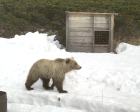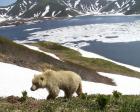
Chico visits the cabin

Biscuit with the lake almost open
(Click on any Image to see a higher resolution version)
A few weeks ago, I got a letter from Melanie Sparks who along with her fiancÚ have conducted a brown bear research / Eco-tourism project on Kodiak Island for the last four summers. They decided to open a wildlife rehabilitation centre in Alaska and hopefully begin reintroducing orphaned Kodiak brown bears. In the course of exploring how they could do this, she learned that it is illegal to rehabilitate and release brown bears in the United States. US Fish and Wildlife told them that years ago, it was decided that brown bears are so intelligent that once they learn to associate humans with food, they will remember for life, making them dangerous to the public. The person she talked to believed that it is unlikely that rehabilitating brown bears will ever clear legislation in that country.
When we got the cubs, the issue of feeding and all the entrenched ideas about what that does to bears, had to be looked at out of simple necessity of keeping them alive. No other challenge associated with this project has caused us more anxiety because of the above beliefs. There were only a couple people who I could find who have looked at the question. One was the famous biologist from Minnesota, Lyne Rogers. His work was with black bears only and done more as methodology for working closely with bears in order to follow and study them. Another was Dr. Pazhetnov, a biologist near Moscow, who has been reintroducing brown bear cubs for years without creating on-going dependence on humans. The difference with our situation was that we would have to feed much longer. As far as we could find, no one anywhere in the world ever conducted a study to explore if there might be a way to feed bears and other animals in a way that didn't cause them to become demanding and otherwise obnoxious and dangerous. So while we were at it we had a small look at this question and the results are definitely not as negative as we have been led to believe.
We got the idea to feed sunflower seeds from Lyne. They are very nutritious and resemble, somewhat the pine nuts that abound in this area. The idea as to how it might be done came from a lifetime of observing animals and feeding them also - cows, horses, dogs, chickadees, and now brown bears. It seems to be true that feeding almost any animal from the hand creates varying degrees of obnoxious behavior, even horses. In the case of bears, real danger. But bears are not the only ones that get dangerous. Coyotes, kangaroos, and deer all get dangerous, to name a few that I have observed. You might even lose an eye to a small bird that is in the habit of taking food from the hand and you are caught some day with nothing to offer. These same animals, if fed in a bird feeder, oat box or some other container, at set times of the day have totally predictable and mellow responses to the people putting out their food. This was the very simple strategy we decided to pursue with our cubs and the results were amazing. They never begged food from us when we were in the field with them. They would show up at feeding time, and if we were out walking when feeding time came around they might disappear towards the cabin and would be waiting there when we got back. They seem to relate to bowls, not us as the source of food. We discontinued their food when they would fail to come for it a couple times in a row when other food started to be plentiful enough to keep them away. When we did this they only came once or twice more and then quickly gave up on the possibility and went to explore for more of the natural food which they were already eating throughout the day. It stands to reason that intermittent food is natural in their world. They can't afford to sit around hoping that the fruit of a berry patch, for instance, will suddenly reappear or the salmon come back until next year. Instead of moping around they become aware of the yearly cycles to be able to take advantage of them very accurately.
After two years of feeding intermittently, I feel that this is another of the many questions that which we have just looked at the surface. It could mean a lot to the bears everywhere if a way was found to feed whole populations, for instance, in times of catastrophic food failures such as there was last year in most of British Colombia and parts of Alberta. In BC, officials admitted to killing nearly 2000 black bears and also many grizzlies, who were forced to explore for food along valley bottoms that are now almost all developed for human use. There were obviously many more bears that met their fate other than the ones reported because this is a province of many guns. Areas that worry about their populations of black bears and perhaps even grizzlies could perhaps intercept them before they get into the towns and cities with some kind of feeding station that would help the bears into hibernation. It could save hundreds of bears in rare years of food failure. With more study about the methodology for doing this, it could maybe be done with virtually no danger to people.
One of the problems, however, in our continuing study and the question of being allowed to work with more cubs (it doesn't look like we will get any more), is that the scientists here and as well in North America, believe that we have created monsters because reintroducing our cubs entailed feeding them. This, despite Dr. Pazhetnov being very successful in his work and the behaviour of Chico and Biscuit being sterling at this date. In our situation we really created skepticism when we had to feed part of the second year as well, due to the lack of natural spring food in this deep snow area. This year (their third), Chico and Biscuit have made it without having been fed at all. They have only come to the cabin four times thus far, and that was only to say hello, or they were just passing through. Perhaps the first couple of times, they did have in mind the possibility of being fed but so subtle was the inquiry that no one except Maureen or I would have recognised their thoughts. At the time I first arrived they were getting virtually nothing to eat and were having to struggle to stay alive yet they had nothing but wonderful manners. Hopefully, our work will help some to realise that despite all that is known about bears there is still some mythology about their true nature and it would help them immensely if we understood more. However, I have come to understand that it is human behaviour that should be in question when bears and people are brought together.
Todays photos show Chico taken on June 3rd, one of the rare times they have come to the cabin. And a recent picture, July 3rd, of Biscuit on the day the lake opened.